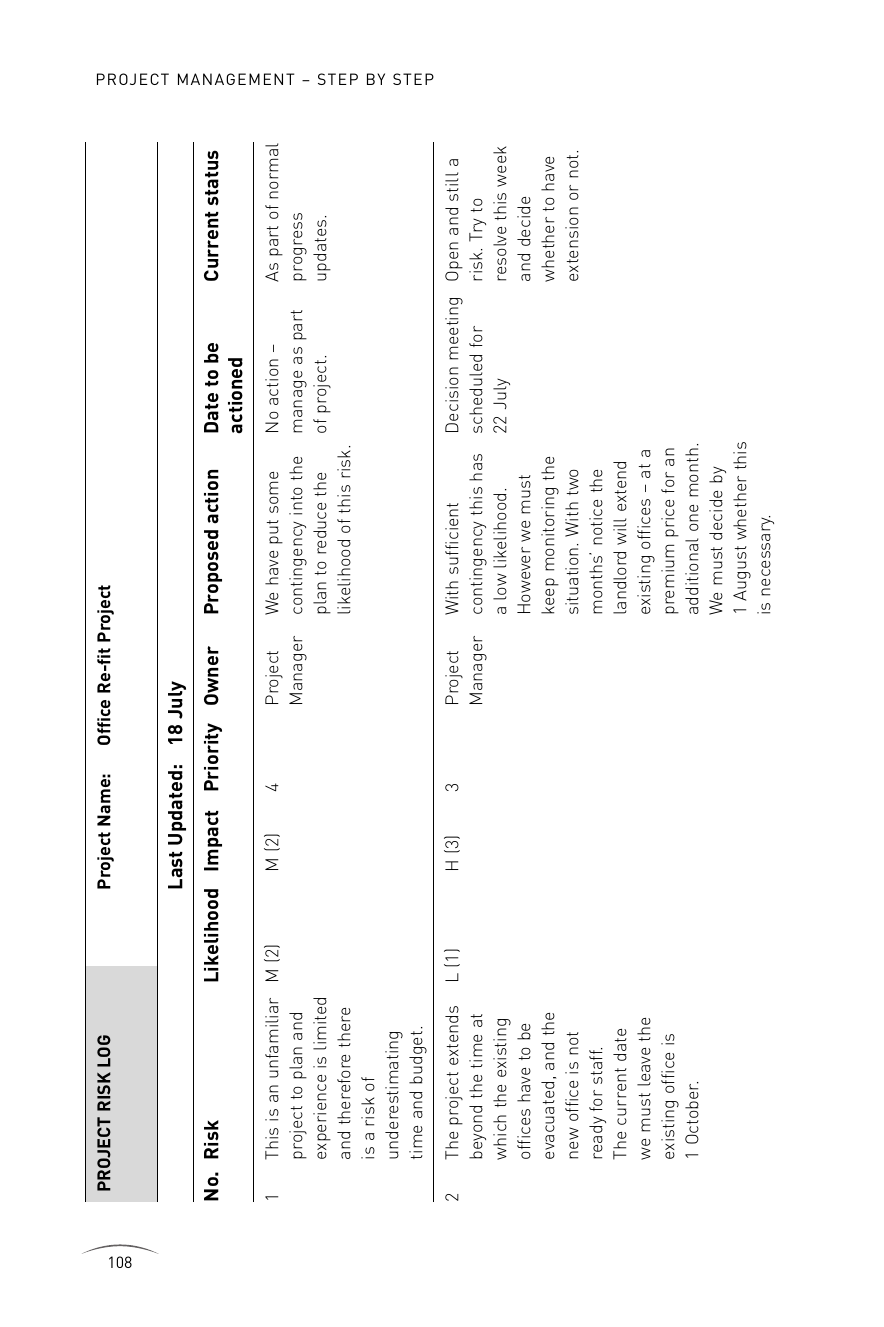
You should manage the actions in the issues log like any other task on
the project and ensure they are being progressed. It is best to review this
log on a daily basis to make sure issues are being resolved. Regularly
contact owners of issues and ask them to confirm progress is being
made. If an issue is having a major impact on the project, or actions are
due for completion in the next day or two, phone whoever is responsible
for the action daily and make sure it is done. At your weekly review
meeting check that the owners are undertaking their actions. Important
information in this table is the ‘Date to be resolved’, which needs to be
treated as if it is a task end date on the plan and should not slip.
Additionally, because some issues do take several weeks to resolve, by
putting information in the ‘Update due’ column, you can start to ensure
that progress is being made even if the issue is not fully resolved.
A sign of a project in trouble is when issues do not get resolved and the
list keeps on getting longer and longer.
Remember your job is to manage the project – not to do everything. So
although you can own some issues, you should not be the owner of all
of them unless it is a one-man project team.
Step 4.6 Identify and manage risks
At the beginning of a project, think of all the risks that exist and priori-
tise them by the impact and likelihood, as described in the section ‘Risks’
at the start of this chapter. Start by reviewing the assumptions in your
Project Definition and decide if any of these add significant risk to your
project.
For larger projects, a good way to do this is to run a brainstorm with the
project team as part of the mobilisation session. Once you have this
initial log, you need to keep it updated. If additional risks are identified,
they should be reported to you. At your weekly review session ask all
team members if there are any new risks.
Once you become aware of risks, then you should document them in a
risk log. For every risk identify:
●
What the risk is.
●
What is the likelihood of it occurring.
PROJECT MANAGEMENT – STEP BY STEP
106
PROM_C04.QXD 1/3/06 9:22 am Page 106

●
What the impact will be, if it occurs.
●
What its overall priority is.
●
Who is responsible for managing this risk.
●
What the next action to resolve this risk is.
●
When any actions need to be completed.
●
What the current status of the risk is.
An example of a risk log is given in Table 4.3.
STEP 4: MANAGE DELIVERY
107
PROM_C04.QXD 1/3/06 9:22 am Page 107

PROJECT MANAGEMENT – STEP BY STEP
108
PROJECT RISK LOG Project Name: Office Re-fit Project
Last Updated: 18 July
No. Risk Likelihood Impact Priority Owner Proposed action Date to be Current status
actioned
1 This is an unfamiliar M (2) M (2) 4 Project We have put some No action – As part of normal
project to plan and Manager contingency into the manage as part progress
experience is limited plan to reduce the of project. updates.
and therefore there likelihood of this risk.
is a risk of
underestimating
time and budget.
2 The project extends L (1) H (3) 3 Project With sufficient Decision meeting Open and still a
beyond the time at Manager contingency this has scheduled for risk. Try to
which the existing a low likelihood. 22 July resolve this week
offices have to be However we must and decide
evacuated, and the keep monitoring the whether to have
new office is not situation. With two extension or not.
ready for staff. months’ notice the
The current date landlord will extend
we must leave the existing offices – at a
existing office is premium price for an
1 October. additional one month.
We must decide by
1 August whether this
is necessary.
PROM_C04.QXD 1/3/06 9:22 am Page 108
Get Project Management Step by Step now with the O’Reilly learning platform.
O’Reilly members experience books, live events, courses curated by job role, and more from O’Reilly and nearly 200 top publishers.

